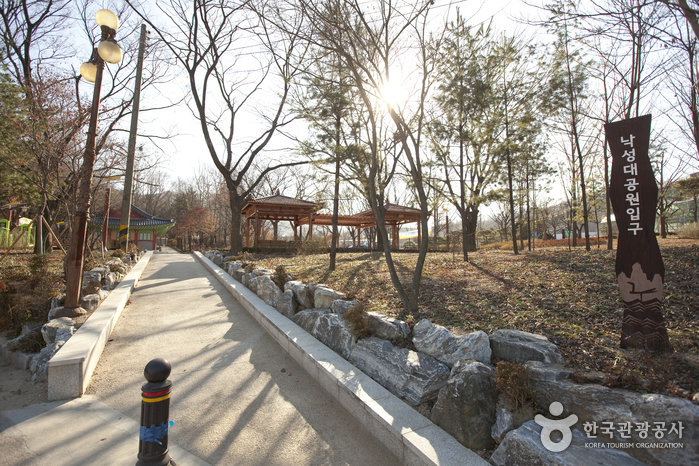Olive Young - Naebang Station Branch [Tax Refund Shop] (올리브영 내방역)
1.7Km 2024-04-22
184, Bangbae-ro, Seocho-gu, Seoul
-
Atelier Plastic Surgery [Tax Refund Shop] (아틀리에성형외과의원)
2.0Km 2024-06-27
89, Donggwang-ro, Seocho-gu, Seoul
-
Gwanaksan Mountain Nakseongdae Park (관악산 낙성대공원)
2.0Km 2021-07-16
77, Nakseongdae-ro, Gwanak-gu, Seoul
+82-2-879-6525
Nakseongdae Park was built as a tribute to General Kang Gam-chan (948-1031) of the Goryeo dynasty. In 1973, the city of Seoul reorganized the birthplace of General Kang, resulting in changes to the park. Located inside the park are Anguksa Shrine, the general’s birthplace, and a three-story stone pagoda, which was made during the Goryeo dynasty. The 4.48-meter-high pagoda is made of granite, and is called “Kang Gam-chan Tap (pagoda)” or “Kang Gam-chan Nakseongdae Tap”.
*Anguksa Shrine
Anguksa is a shrine built in 1974 emulating the wooden architecture style of the Goryeo era. The shrine has high ceilings and houses the portrait of General Kang Gam-chan. The shrine is located on the road leading to the back gate of Seoul National University and has become a popular place in the area.
*Nakseongdae Yuji
Nakseongdae Yuji is the birthplace of General Kang Gam-chan and the original location of the three-story pagoda. During the maintenance of Nakseongdae area in 1973, the pagoda was moved into the vicinity of Anguksa Shrine, and a two-meter tall monument was erected in its original location to mark the historical significance of the site.
Gwanak Kang Gam-chan Festival (관악강감찬축제)
2.1Km 2025-07-11
77 Nakseongdae-ro, Gwanak-gu, Seoul
+82-2-828-5765
The Gwanak Gang Gam-chan Festival is a historical and cultural event held to honor the patriotic spirit of General Gang Gam-chan, a famous general from the Goryeo Dynasty. The festival is known for its impressive night events, fitting for the location named after a falling star, and features a variety of parades and performances.
◎ Gang Gam-chan and Nakseongdae
General Gang Gam-chan of Goryeo is said to have been born at the place where the fourth star of the Big Dipper fell. This place is called Nakseongdae, which means “the place where the star fell.”
Simsan Cultural Center (심산기념문화센터)
2.4Km 2022-01-04
55, Sapyeong-daero, Seocho-gu, Seoul
+82-2-3477-2461
The Simsan Cultural Center was established to commemorate the Confucianism and patriotic spirit of Simsan Kim Chang-Suk. It also offers educational and training programs to the local community for developing life skills while adding to the overall quality of life.
Ssukgogae (쑥고개)
2.4Km 2024-02-15
B1, 16 Gwanak-ro 14-gil, Gwanak-gu, Seoul
Ssukgogae is a Korean and Western fusion restaurant situated at the beginning of Syarosu-gil. The standout menu item is the tong samgyeop kimchi jjim (braised whole pork belly with kimchi), a robust and spicy dish prepared with whole pork belly and soft bean curd. Another crowd-pleaser is the chicken cheongyang cream pasta (deep-fried chicken and cheongyang chili pepper cream pasta), featuring crispy fried shrimp and deep-fried chicken generously layered on soy cream sauce. The waffle gamja jeon (potato pancake), crispy and adorned with grated grana padano cheese, also earns acclaim. Nearby attractions encompass Nakseongsan Mountain, Nakseongdae Park, and Gwaneumsa Temple.
ABC-Mart - Seoul National University Station Branch [Tax Refund Shop] (ABC마트 서울대점)
2.5Km 2024-06-27
172, Gwanak-ro, Gwanak-gu, Seoul
-
Seorae Village (서래마을)
2.5Km 2022-12-16
Banpo-dong, Seocho-gu, Seoul
+82-2-2155-6220
Seorae Village is located in between Banpo 4-dong and Bangbaebon-dong in Seocho-gu, Seoul. Seorae Village took its form as a French neighborhood when French residents moved to the area after Ecole Francaise de Seoul, a school for French residents in Korea, was established here in 1985. According to 2008 census, about half of the total 1,000 French citizens residing in Korea were registered to be living in Seorae Village. The area naturally took shape as a global neighborhood as many international residents settled at Seorae Village much thanks to the strong presence of French residents. In addition to its convenient location near the central district area as well as Gangnam area and Hangang River Park, Seorae Village serves as a pleasant environment space for all.
Many shops and restaurants in Seorae Village are small in size and rather charming, resembling those in Europe. A bakery that makes traditional French baguettes using ingredients directly imported from France can be found here. In recent years, Seorae Village has undergone several changes, gaining much attention as one of the most modern and fanciest regions found in Seoul.
National Gugak Museum (국립국악박물관)
2.5Km 2021-08-13
2364, Nambusunhwan-ro, Seocho-gu, Seoul
+82-2-580-3130
The National Gugak Museum opened on February 23, 1995 as the first gugak museum in Korea, featuring approximately 6,000 pieces of gugak-related materials and relics which have both historical and cultural value. It is comprised of seven themed permanent exhibition halls that present 250 pieces of audio and video clips regarding gugak. In the 3D room, visitors can enjoy 3D animation at all times. The museum also hosts special exhibitions in unique and interesting themes.
National Gugak Center (국립국악원)
2.5Km 2025-01-17
2364 Nambusunhwan-ro, Seocho-gu, Seoul
The National Gugak Center is the governing body established to preserve and promote traditional Korean performing arts. The center can accommodate every type of traditional performing arts, such as palace music, court music, and all other genres including major productions of changgeuk (Korean musical drama). Originally opened in Busan in 1951, the center moved to its current location in Seoul in 1987. The center also opened branch locations in Namwon, Jindo, and Busan in 1992, 2004, and 2008 respectively.
![Olive Young - Naebang Station Branch [Tax Refund Shop] (올리브영 내방역)](http://tong.visitkorea.or.kr/cms/resource/83/2889483_image2_1.jpg)
![Atelier Plastic Surgery [Tax Refund Shop] (아틀리에성형외과의원)](http://tong.visitkorea.or.kr/cms/resource/95/3314395_image2_1.jpg)


![ABC-Mart - Seoul National University Station Branch [Tax Refund Shop] (ABC마트 서울대점)](http://tong.visitkorea.or.kr/cms/resource/82/3314782_image2_1.jpg)

 English
English
 한국어
한국어 日本語
日本語 中文(简体)
中文(简体) Deutsch
Deutsch Français
Français Español
Español Русский
Русский